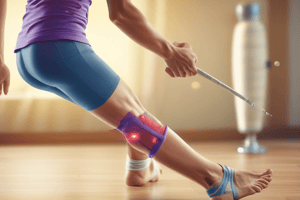Podcast
Questions and Answers
What is the primary purpose of Grade I and II mobilizations?
What is the primary purpose of Grade I and II mobilizations?
- To strengthen joint structures
- To increase range of motion
- To modulate pain (correct)
- To improve postural alignment
In the context of peripheral joint mobilization, what is the position of the shoulder in open pack position?
In the context of peripheral joint mobilization, what is the position of the shoulder in open pack position?
- Abd 55, H Add 30 (correct)
- Abd 30, H Add 55
- PF 10
- Flx 30, Abd 30
Which grade of joint mobilization involves oscillating movements at the end range of motion?
Which grade of joint mobilization involves oscillating movements at the end range of motion?
- Grade III
- Grade IV (correct)
- Grade I
- Grade II
What characterizes a Grade III mobilization?
What characterizes a Grade III mobilization?
Which joint is characterized by a convex femur and concave acetabulum in the open pack position?
Which joint is characterized by a convex femur and concave acetabulum in the open pack position?
Match the following joint mobilization grades with their descriptions:
Match the following joint mobilization grades with their descriptions:
Match the following joint and their open pack positions with their respective positions:
Match the following joint and their open pack positions with their respective positions:
Match the following terms related to joint anatomy with their definitions:
Match the following terms related to joint anatomy with their definitions:
Match the benefits of joint mobilization grades with their corresponding grades:
Match the benefits of joint mobilization grades with their corresponding grades:
Match the following components of the ankle joint with their characteristics:
Match the following components of the ankle joint with their characteristics:
Grade III mobilization involves oscillating small amplitude movements at the beginning of the range of motion.
Grade III mobilization involves oscillating small amplitude movements at the beginning of the range of motion.
The open pack position for the knee in flexion is characterized by a convex patella and concave tibia.
The open pack position for the knee in flexion is characterized by a convex patella and concave tibia.
Grade I and II mobilizations are primarily used to increase range of motion (ROM) in joints.
Grade I and II mobilizations are primarily used to increase range of motion (ROM) in joints.
The open pack position for the hip consists of flexion of 30 degrees, abduction of 30 degrees, and slight external rotation.
The open pack position for the hip consists of flexion of 30 degrees, abduction of 30 degrees, and slight external rotation.
Grade IV mobilization is identified by oscillating large amplitude movements in the mid range of motion.
Grade IV mobilization is identified by oscillating large amplitude movements in the mid range of motion.
Flashcards
Peripheral Joint Mobilization
Peripheral Joint Mobilization
Manual therapy technique used to improve joint movement and reduce pain by manipulating the joint capsule, ligaments and surrounding tissues.
Open Pack Position
Open Pack Position
Joint position where the joint capsule and ligaments are most relaxed, allowing easier movement and reducing stress on the tissues.
Grade I Joint Mobilization
Grade I Joint Mobilization
Small amplitude oscillatory movements at the beginning of the joint's range of motion.
Grade II Joint Mobilization
Grade II Joint Mobilization
Signup and view all the flashcards
Mobilization with Stretch vs. Passive Stretch
Mobilization with Stretch vs. Passive Stretch
Signup and view all the flashcards
Caudal
Caudal
Signup and view all the flashcards
Dorsal
Dorsal
Signup and view all the flashcards
Volar
Volar
Signup and view all the flashcards
Grade I Mobilization
Grade I Mobilization
Signup and view all the flashcards
Open Pack Position (Shoulder)
Open Pack Position (Shoulder)
Signup and view all the flashcards
Open Pack Position (Hip)
Open Pack Position (Hip)
Signup and view all the flashcards
Open Pack Position (Knee - Patellofemoral)
Open Pack Position (Knee - Patellofemoral)
Signup and view all the flashcards
Open Pack Position (Knee - Tibiofemoral)
Open Pack Position (Knee - Tibiofemoral)
Signup and view all the flashcards
Open Pack Position (Ankle)
Open Pack Position (Ankle)
Signup and view all the flashcards
Study Notes
Peripheral Joint Mobilization Advantages
- Mobilization with stretching is more beneficial than passive stretching alone.
Terminology
- Caudal: Located towards the tail end.
- Dorsal: Located on the back.
- Volar: Located on the palm side (hand) or sole (foot).
Open Pack Positions
- Shoulder:
- Abduction (Abd) 55 degrees, Horizontal Adduction (H Add) 30 degrees (in the plane of the scapula).
- Convex-humerus, concave-glenoid.
- Hip:
- Flexion (Flx) 30 degrees, Abduction 30 degrees, slight External Rotation (ER).
- Convex-femur, concave-acetabulum.
- Knee (patello-femoral):
- Extension
- Convex-patella, concave-tibia.
- Knee (tibio-femoral):
- Flexion (Flx) 25 degrees.
- Convex-femur, concave-tibia.
- Ankle:
- Plantar Flexion (PF) 10 degrees.
- Convex-talus, concave-tibia and fibula.
Grade I-IV Mobilization
- Grade I:
- Small amplitude oscillatory movement at the beginning of the range of motion.
- Grade II:
- Larger amplitude oscillatory movement in the mid-range of motion. Does not reach the first restriction.
- Grade III:
- Large amplitude oscillatory movement from the mid-range to end range, into tissue resistance.
- Grade IV:
- Small amplitude oscillatory movement at the end range of motion.
- Grade I and II Benefits:
- Primarily for pain modulation.
- Unloads and decompresses.
- Often used with stretching.
- Stimulates synovial fluid to nourish cartilage.
- Maintains joint play in the face of limited ROM and often used as the first treatment to understand joint restrictions (Grade II).
- Grade III and IV Benefits:
- Used to increase range of motion.
- Stretches joint structures and increases joint play.
Studying That Suits You
Use AI to generate personalized quizzes and flashcards to suit your learning preferences.




